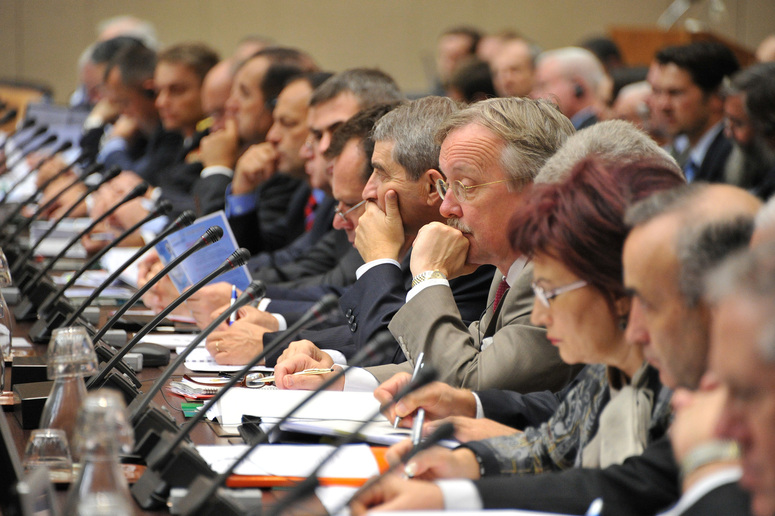Communications and public diplomacy
NATO communicates and develops programmes to help raise awareness and understanding of the Alliance and Alliance-related issues and, ultimately, to foster support for, and trust in, the Organization. Since NATO is an intergovernmental organisation, individual member governments are also responsible for explaining their national defence and security policies as well as their role as members of the Alliance to their respective publics.

- NATO promotes public debate and understanding of the Alliance through direct engagement, both digitally and in person, while coordinating with NATO members on an ongoing basis.
- The Public Diplomacy Division at NATO Headquarters harmonises all public diplomacy activities and coordinates communication activities NATO-wide.
- The military commands and the International Military Staff also communicate on activities under their responsibility, in accordance with agreed NATO policies.
- Overall guidance and direction to NATO’s communications efforts and information activities is provided by the North Atlantic Council (NAC) and specific guidance and direction is given by the Secretary General.
Role of communications and public diplomacy
The overall aim of NATO’s communications activities is to promote dialogue and understanding, while contributing to the public’s knowledge of security issues and promoting public involvement in a continuous process of debate on security.
To do so, NATO engages with the media, develops communications and public diplomacy programmes for selected groups including opinion leaders, academic and parliamentary groups, youth and educational circles. It seeks to reach audiences worldwide via its various platforms and social media activities. It also disseminates materials and implements programmes and activities with external partners, while at the same time supporting the NATO Secretary General in his role as the principal spokesperson for the Alliance.
This drive to inform and engage with the public is reinforced by the knowledge that NATO is accountable to its member governments and their taxpayers who fund the Organization. As such, and in a spirit of transparency, it explains its policies, activities and functions.
Promoting security cooperation
Stimulating debate on NATO issues contributes to strengthening knowledge of the Alliance’s goals and objectives. Many of NATO’s information activities have an interactive, two-way nature, enabling the Organization to listen to and learn from the experience of its audiences, identify their concerns and fields of interest and respond to their questions. For instance, NATO has information points and/or offices in partner countries and so-called “contact point embassies”, which are NATO member country embassies located in partner countries. They all enable NATO to engage with local audiences and increase the impact of its work.
Types of activities
Today, the Alliance uses internet-based media, social media platforms and public engagement, in addition to traditional media, to build awareness of and support for NATO’s evolving role, objectives and missions. In short, the Alliance employs a multi-faceted and integrated approach in communicating and engaging with the wider public.
Over time, programmes and policy have adapted to changes in the political and security environment, as well as to the technical innovations that have a direct impact on communication work. The communications services provided by NATO itself have also been reformed and restructured on numerous occasions to adapt to the different needs of the constantly evolving information environment, as well as to the needs of the security environment
Working mechanisms
The NAC and Secretary General are in charge of the overall direction of communications and public diplomacy programmes for both the civilian and military sides of the Alliance.
The NATO Deputies Committee guides overall strategic communications on behalf of the NAC. Issue-specific NATO committees provide more detailed guidance, commenting on issues ranging from NATO maritime strategy to operations.
The Committee on Public Diplomacy (CPD) acts as an advisory body to the NAC on communication, media and public engagement issues. It makes recommendations to the NAC regarding how to encourage public understanding of, and support for, the goals of the Alliance.
At NATO Headquarters, members of the Public Diplomacy Division, who run communications and public diplomacy programmes from within the International Staff, work closely with the International Military Staff and, more specifically, the Public Affairs and Strategic Communications Advisor to the Chair of the Military Committee (MC). PDD also works with staff from the two strategic commands – Allied Command Operations (ACO) and Allied Command Transformation (ACT) – who communicate on operations, exercises and other activities under their purview. The interaction between the civilian and military side of the Alliance is key in ensuring a coherent and consistent approach to communications NATO-wide.
Evolution of communications
The founding members of NATO understood the importance of informing public opinion. On 18 May 1950, the NAC issued a resolution in which it committed itself to: “Promote and coordinate public information in furtherance of the objectives of the Treaty while leaving responsibility for national programs to each country...” As early as August 1950, a modest NATO Information Service was set up and developed in the autumn with the nomination of a director. The service – similarly to the rest of the civilian organisation of the Alliance – did not receive a budget until July 1951. It effectively developed into an information service in 1952, with the establishment of an International Staff headed by a Secretary General (March 1952), to which the information service was initially attached.
Later, in 1953, the Committee on Information and Cultural Relations (now the Committee on Public Diplomacy) was created. As such, from 1953, every mechanism was in place for the development of fully-fledged communications and information programmes.
In 1956, the Report of the Three Wise Men stressed the overall importance of non-military cooperation and the need to develop unity within the Alliance. Cooperation in the information field was identified as one of the areas the Alliance should reinforce, stating, “The people of the member countries must know about NATO if they are to support it.” To do so, it recommended, “The promotion of information about, and public understanding of NATO and the Atlantic Community should, in fact, be a joint endeavor by the Organization and its members”.
